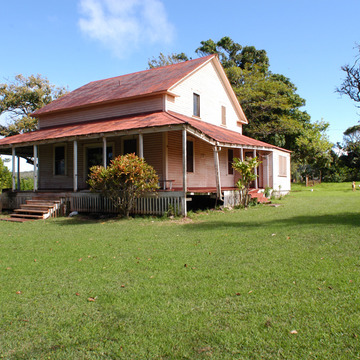During the last half of the nineteenth century, Kalae was a rare outpost of Western civilization on the island of Molokai, due to Rudolph Wilhelm Meyer. The dominant figure in the written history of nineteenth-century Molokai, Meyer was born in Germany in 1826. He graduated from the Hochschule in Hamburg as a civil engineer, with expertise in hydraulics and surveying. At the age of twenty-two, he departed Germany, arriving in Honolulu by way of Australia in January 1850. By September, he was employed by the Kingdom of Hawaii as a surveyor of land claims generated by the Great Mahele two years earlier. In October 1850, this job brought him to Kaluaaha. Aside from missionaries, few foreigners ventured to this island, and as traveler George Washington Bates noted in 1854, non-Hawaiians “were usually objects of great curiosity.” Here Meyer remained, and in March 1851, he married an eighteen-year-old Hawaiian from Pukoo, Dorcas Kalama Waha. The Meyers stayed on the east end of Molokai for several years, then in 1854 acquired more than two hundred acres at Kalae from the government and built this house. Much of these lands remain in family hands.
Meyer retained close ties with the monarchy, and at various times held eighteen different public positions on Molokai, including Health Superintendent of Molokai and Kalaupapa, Supervisor of Wharves, Supervisor of Lighthouses and of Roads, Commissioner of Fences, School Agent, Agent to Grant Marriage Licenses, Agent to Take Acknowledgement of Instruments, Postmaster, Inspector of Elections, and Inspector of Stallions. However, his primary occupation was managing the Kamehamehas' ranch lands. He held this position from the inception of the ranch in 1859 until his death in 1897. He also managed his own ranching operation at Kalae. Here he grew coffee, corn, potatoes, vegetables, grapes, fruit trees, sugar cane, and wheat, and kept silkworms, bees, and dairy cows.
The Meyers' mid-nineteenth-century house sits back from the road on the west side of Kalae Highway above the sugar mill. Standing a full two stories, its massing augmented by a wraparound shed-roofed lanai, it would have seemed palatial when compared to the thatched houses occupied by most of Molokai's population. The pedimented openings and the roof's gable returns, associated with the earlier Greek Revival, added a further sense of grandeur. A Victorian jigsaw balustrade once adorned the lanai, but disappeared in recent years as the dwelling slowly deteriorated.





















